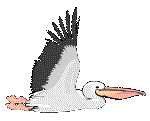Flight Behavior II: Type of
Flight

Characteristics of Flapping, Gliding, and
Soaring Flight
Classifying a butterflies flight mode as either flapping, gliding, or soaring, is easy - as long as its flapping. Flapping Flight is characterised by regular wing beats and is the main type of flight observed when the butterflies are flying within a few meters of the ground. Most difficulties arise when you have to distinguish between gliding and soaring flight.
Gliding and Soaring flight are both characterised by the wings being held outspread and still. Although there are a few rules to apply, distinguishing between the two types of flight can be difficult. Gliding butterflies always lose altitude. In contrast, Soaring butterflies, by definition, either maintain, or gain altitude. Although soaring butterflies seem to defy gravity, they are actually just gliding in rising air. The air is rising as fast, or faster, than the butterflies gliding rate of descent. A soaring butterfly may circle or fly straight, depending upon the circumstances. Soaring butterflies often fly straight along the rising air on the windward side of a hill, ravine, or building, particularly when it is approximately in line with their preferred direction. Soaring butterflies usually circle when they encounter a small narrow thermal near (e.g. within 10 m - 30 m ) the ground and continue to circle as they gain altitude. On the other hand, individuals at higher altitudes may mill about in an apparently haphazard manner or fly straight across thermals. Gliding butterflies seldom circle. Although a gliding butterfly may turn towards trees, or a field of flowers as it gets closer to the ground, in open areas they usually just continue to glide straight ahead, finally switching to flapping flight within 1 - 3 meters of the ground. On days with tailwinds and good soaring weather (plenty of fair weather cumulus clouds), monarch butterflies can often be observed gliding down from high altitudes shortly before sunset as thermal activity finally dies out. Gliding flight can also be apparent when the butterflies abruptly turn out of thermals within about 30 m of the ground.
Although a gliding monarch butterfly has a relatively steep angle of descent, nearly 1 m of altitude lost for every 3.6 m of forward flight, determining that a butterfly is actually descending can be very difficult, particularly if the migrant is being rapidly carried downwind. To further complicate matters, butterflies gliding through an area of slowly rising air (weak lift) will descend slower and appear to have a significantly shallower (flatter) glide angle than 3.6:1 Glider pilots call this type of weak lift reduced sink, and it's not to be scorned, particularly when thermals are dying at the end of the day and there is little else up there to bring you back to the field. Similarly, a monarch descending from cloudbase can achieve glide ratios of 7.2:1 if it encounters weak lift that reduces it rate of descent by 50%, 14.4:1 if it reduces its rate of descent by 75%, and even 28.8:1 if it is able to reduce its rate of descent by 87.5%. Of course, if if finds weak lift that exactly matches its rate of descent (called zero sink by glider pilots), its now soaring and can maintain altitude without flapping for as long as it stays in the rising air.
Because it is often difficult to distinguish between gliding and soaring flight in the field, and because gliding flight often has a pinch, or more than a pinch of soaring (because of weak lift), slowing the butterflies' rate of descent, I use a few simple rules to decide whether an individual is gliding or soaring. Gliding butterfly are: (1) not flapping their wings, and (2) visibly descending. Soaring butterflies are: (1) not flapping their wings, and (2) not visibly descending. This method greatly simplifies matters and avoids endless arguments with myself when making observations. Fortunately, researchers interested in energetics of the migration are primarily concerned with the proportion of the time spent in flapping and non-flapping (gliding and soaring) flight. Similarly, researchers interested in flight tactics are more interested in the proportion of the flight time spent aloft soaring in thermals compared to flapping along near the ground. Finally, keep in mind that the butterflies regularly switch among flight modes. For example, a monarch may flap up to a thermal, soar in circles for a few turns, then leave the thermal and glide back to the ground. When something like this happens, all three flight modes should be checked off on the data forms.